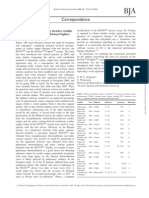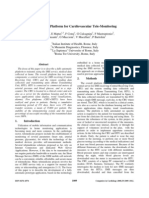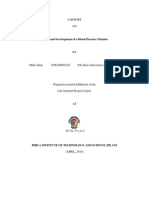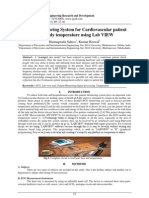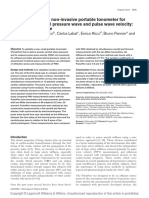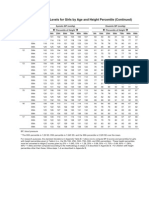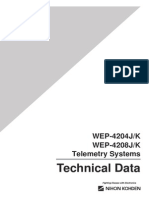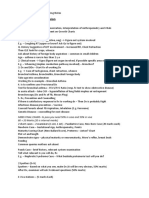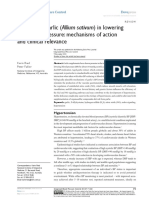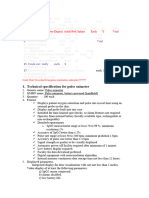Get TRDoc
Get TRDoc
Uploaded by
Nikitha NiksCopyright:
Available Formats
Get TRDoc
Get TRDoc
Uploaded by
Nikitha NiksOriginal Title
Copyright
Available Formats
Share this document
Did you find this document useful?
Is this content inappropriate?
Copyright:
Available Formats
Get TRDoc
Get TRDoc
Uploaded by
Nikitha NiksCopyright:
Available Formats
NONINVASIVE AND CUFFLESS MEASUREMENTS OF BLOOD PRESSURE FOR TELEMEDICINE
K.W. Chan, K. Hung, Y. T. Zhang,
Joint Research Center for Biomedical Engineering Department of Electronic Engineering, The Chinese University of Hong Kong, Shatin, N.T. Hong Kong
Abstract-This paper presents a new method for obtaining the blood pressure readings noninvasively with telemedicine application. Through the pulse transit time technique, the systolic, diastolic, and mean blood pressures can be predicted using the time interval between the electrocardioacgram (ECG) and photoplethysmography (PPG). The data can then be relayed to the Internet for analysis and viewing. The wireless application protocol (WAP) is used for displaying the information on portable wireless devices. The subjects cardiovascular condition can thus be obtained for monitoring or pre-diagnosis purposes. Keyword: Blood Pressure, Telemedicine, Cuffless, WAP
II. METHODOLOGY The ECG and PPG signals were obtained using a physiological measurement system at our lab, and recorded by a computer through an A/D converter at a sampling rate of 1500Hz. At the same time, the BPs were obtained by a standard blood pressure meter that used the oscillometric method for calibrations. The principle of the PTT approach to measure blood pressure issue in Figure 1. Since the blood pressure can vary from beat to beat, five consecutive ECG-pulse intervals were used to get an average PPT value [3]. For the calibration, each subject was requested to perform twenty trials of measurements.
I. INTRODUCTION Periodically obtained blood pressure (BP) measurement is necessary for observing the cardiovascular state of patients over a predefined period. The variation in the blood pressure provides significant information on the status of the patient. It would be useful to measure the BP information remotely and noninvasively through telemedicine technique. The conventional noninvasive BP measurement technique is not suitable for obtaining continuous blood pressure values due to the periodic cuff inflation and deflation. Frequent occlusion of artery will also induce measurement error. Recently, a modified cuffless technique, based on the pulse transit time (PTT), has been studied for predicting the BP [1]. The BP can be determined from the pulse wave velocity (PWV), which is the inverse of the PTT by the equation introduced by the Bramwell and Hill [2], c2 = pV/ v ,
T
Fig 1: The time interval T as a blood pressure index
After the initial calibration, the regression line was obtained for each subject. This line formed a linear function between the blood pressure and the PTT (Fig. 2). When the PTT was input to the function, the corresponding blood pressure value could be calculated.
where c = PWV, meters/sec, p = change in pressure, v = change in volume, V = initial volume, and =density of fluid. This means that a higher BP corresponds to a shorter PTT, and vice versa. This technique is noninvasive and is easy to be implemented. The data obtained by this technique can then be uploaded to the Internet for remote access and analysis. A current trend in telecommunication and telemedicine is the convergence of cellular phone and computer network technologies [4]. The emergence of devices compatible with the wireless application protocol (WAP) is an example. This paper will present a WAP-based telemedicine system for the noninvasive measurements of arterial blood pressure.
Fig 2: The regression line for the PTT versus the blood pressure.
Different regression lines were used to represent systolic, diastolic and mean pressures. These three values were then uploaded to the Internet for viewing at a computer or a WAP device.
Report Documentation Page
Report Date 25OCT2001 Report Type N/A Dates Covered (from... to) Contract Number Grant Number Program Element Number Author(s) Project Number Task Number Work Unit Number Performing Organization Name(s) and Address(es) Joint Research Center for Biomedical Engineering Department of Electronic Engineering, The Chinese University of Hong Kong, Shatin, N.T. Hong Kong Sponsoring/Monitoring Agency Name(s) and Address(es) US Army Research Development & Standardization Group (UK) PSC 803 Box 15 FPO AE 09499-1500 Distribution/Availability Statement Approved for public release, distribution unlimited Supplementary Notes Papers from the 23rd Annual International conference of the IEEE Engineering in Medicine and Biology Society, October 25-28, 2001, held in Istanbul, Turkey. See also ADM001351 for entire conference on cd-rom., The original document contains color images. Abstract Subject Terms Report Classification unclassified Classification of Abstract unclassified Number of Pages 2 Classification of this page unclassified Limitation of Abstract UU Performing Organization Report Number
Title and Subtitle Noninvasive and Cuffless Measurements of Blood Pressure for Telemedicine
Sponsor/Monitors Acronym(s) Sponsor/Monitors Report Number(s)
Figure 3 shows a WAP communication model [5]. The wireless user agent, possibly a WAP phone, connects to the WAP Gateway, which translates and passes information between the user and the server. A WAP application was developed for displaying the obtained blood pressure values.
WAP Gateway User Agent Content Server
Fig 3: WAP communication model
The user-interface part was written in wireless markup language (WML) and WMLScript. These are executed at the WAP device after they have been downloaded from the server. The other part of the application, written in Perl, executed on the server side, and was used for dynamically creating graphs in wireless bitmap (WBMP) format and WML upon the users requests. A database was also set up for convenient access of the pressure values. Both the application and database were stored at the server. III. RESULTS Table I shows that the comparison between the results measured by the commercial cuff BP meter and the results predicted by the cuffless method with respect to systolic, mean, and diastolic pressures.
TABLE I COMPARING THE MEASURED AND PREDICTED RESULTS Mean Difference ( mmHg ) Systolic Mean Diastolic Standard Deviation ( mmHg )
Fig 4: Interfaces on an actual WAP phone. Top-left and Bottom left: menus. Top-right: Plot of systolic pressure values for a predefined period. Bottomright: Blood pressure values for a specified measurement.
The initial calibration is required on each subject because of different physiological parameters, such as the blood density and the stiffness of the arterial wall. However, those parameters can be treated as constant for each personal subject. Taking several measurements, in this case twenty sets were used, the linear regression line is established. Then the blood pressure can be predicted based on the PTT. However, the prediction accuracy depends on the accuracy of the initial calibration, so the blood pressure, ECG and PPG measurements should be performed with the standard devices to obtain high accuracy results. The number of measurements can be altered during the initial calibration. But 5-6 times of measurements were formal to be acceptable to obtain a reasonable regression line. In conclusion, the advantages of this technique of noninvasive and cuffless blood pressure measurement allow doctors and clinicians to obtain the patients cardiovascular status remotely and continuously through a WAP device. VI. REFERENCE [1] K.W.Chan & Y.T. Zhang, A noninvasive and cuffless method for the measurements of blood pressure. (submitted for publication) [2] Bramwell, J.C. & Hill, A.V. The velocity of the pulse wave in man. Proceedings of the Royal Society, London, 1922, 93, 298-306. [3] James D. Lane, Lisa Greenstadt, David Shapiro, Pulse Transit Time and Blood Pressure: An Intensive Analysis, Psychophysiology,1983, Vol. 20, No.1, p.45-49. [4] K. Hung, Y.T. Zhang, On the Feasibility of the Usage of WAP Devices in Telemedicine. ITAB2000-ITIS2000, Arlington, 2000. [5] S. Mann, Programming Applications with the Wireless Application Protocol: the complete developers guide. New York: John Wiley & Sons, Inc., 1999.
7.487 6.113 4.076
8.824 5.581 5.617
A WAP phone compliant with WAP 1.1 was used at GSM 1800MHz to access the WAP site. The gateway used in the link was provided by a mobile phone service provider in Hong Kong. Figure 4 shows user interfaces and the blood pressure values being displayed in charted and graphical forms on a WAP phone IV. DISCUSSION AND CONCLUSION To include the BP readings in telemedicine, automation and continuous measurement are very important. However, most of the automated clinical non-invasive blood pressure meters use oscillometric techniques. It requires a cuff, and is not suitable for continuous BP measurements. To overcome this problem, PTT is recommended to act as an index to predict the blood pressures. PTT measurements only involve the ECG and PPG, both of which can be measured noninvasively and continuously without cuffs. Thus, the blood pressures can be predicted continuously at the same time.
You might also like
- Sensors 20 00851 v2 PDFDocument12 pagesSensors 20 00851 v2 PDFsalemNo ratings yet
- A Blood Pressure Prediction Method Based On Imaging Photoplethysmography in Combination With Machine LearningDocument11 pagesA Blood Pressure Prediction Method Based On Imaging Photoplethysmography in Combination With Machine LearningPING KWAN MANNo ratings yet
- Blood PresuareDocument4 pagesBlood PresuareIsabel KingNo ratings yet
- PPG TheroyDocument21 pagesPPG Theroylorenzodamico163No ratings yet
- Wavelet Based Pulse Rate and Blood Pressure Estimation System From ECG and PPG SignalsDocument5 pagesWavelet Based Pulse Rate and Blood Pressure Estimation System From ECG and PPG SignalsMatthew ChurchNo ratings yet
- The Development of A Low-Cost, Open Source SpirometerDocument7 pagesThe Development of A Low-Cost, Open Source SpirometerAllanNo ratings yet
- Improvements in Indirect Blood Pressure Estimation Via Electrocardiography and PhotoplethysmographyDocument6 pagesImprovements in Indirect Blood Pressure Estimation Via Electrocardiography and Photoplethysmographysojogil742No ratings yet
- Paper of Blood Pressure Estimation Using Machine LearningDocument11 pagesPaper of Blood Pressure Estimation Using Machine LearningNashat MaherNo ratings yet
- 1 s2.0 S1746809422001033 MainDocument14 pages1 s2.0 S1746809422001033 MainAyush Kar MohapatraNo ratings yet
- 2111.08480Document22 pages2111.08480osamawin1997No ratings yet
- Correspondence: Performance of A Minimally Invasive Cardiac Output Monitoring System (Flotrac/Vigileo)Document2 pagesCorrespondence: Performance of A Minimally Invasive Cardiac Output Monitoring System (Flotrac/Vigileo)alky77No ratings yet
- An Interfacing Digital Blood Pressure Meter With arduino-GSM Module For Real-Time MonitoringDocument5 pagesAn Interfacing Digital Blood Pressure Meter With arduino-GSM Module For Real-Time MonitoringHemank SoniNo ratings yet
- SMS-Based Platform For Cardiovascular Tele-Monitoring: 2. MethodsDocument4 pagesSMS-Based Platform For Cardiovascular Tele-Monitoring: 2. MethodsJeeta DashNo ratings yet
- Biomedical Signal Processing and Control: Sourav Kumar Mukhopadhyay, M. Omair Ahmad, M.N.S. SwamyDocument13 pagesBiomedical Signal Processing and Control: Sourav Kumar Mukhopadhyay, M. Omair Ahmad, M.N.S. SwamyfatimaNo ratings yet
- Ijecet: International Journal of Electronics and Communication Engineering & Technology (Ijecet)Document10 pagesIjecet: International Journal of Electronics and Communication Engineering & Technology (Ijecet)IAEME PublicationNo ratings yet
- Estimation of Blood Pressure Levels From Reflective Photoplethysmograph Using Smart PhonesDocument5 pagesEstimation of Blood Pressure Levels From Reflective Photoplethysmograph Using Smart PhonesNguyễn CươngNo ratings yet
- Abstract SetDocument55 pagesAbstract SetelfotsonNo ratings yet
- Estimation of Arterial Stiffness by Using PPG Signal: A ReviewDocument4 pagesEstimation of Arterial Stiffness by Using PPG Signal: A ReviewseventhsensegroupNo ratings yet
- Applied Sciences: P-Wave Detection Using A Fully Convolutional Neural Network in Electrocardiogram ImagesDocument17 pagesApplied Sciences: P-Wave Detection Using A Fully Convolutional Neural Network in Electrocardiogram ImagesnadhemNo ratings yet
- Real-Time ECG Telemonitoring System Design With Mobile Phone PlatformDocument8 pagesReal-Time ECG Telemonitoring System Design With Mobile Phone PlatformkrajasekarantutiNo ratings yet
- An Armband Wearable Device For Overnight and Cuff-Less Blood Pressure MeasurementDocument8 pagesAn Armband Wearable Device For Overnight and Cuff-Less Blood Pressure Measurementlorenzodamico163No ratings yet
- Arterial Blood Pressure Feature Estimation Using PlethysomographDocument12 pagesArterial Blood Pressure Feature Estimation Using PlethysomographLevente BalázsNo ratings yet
- ECG Simulation Using Fourier Series From Personal Computers To Mobile DevicesDocument9 pagesECG Simulation Using Fourier Series From Personal Computers To Mobile DevicesEditor IJRITCCNo ratings yet
- Wireless Photoplethysmography Sensor For ContinuouDocument9 pagesWireless Photoplethysmography Sensor For Continuouavinandan.mallickNo ratings yet
- Analog Front End Design of A Digital Blood Pressure Meter IJERTV4IS050866Document5 pagesAnalog Front End Design of A Digital Blood Pressure Meter IJERTV4IS050866Emilio CánepaNo ratings yet
- Instruments and Methods For Calibration of Oscillometric Blood Pressure Measurement DevicesDocument14 pagesInstruments and Methods For Calibration of Oscillometric Blood Pressure Measurement DevicesHoliNo ratings yet
- Wireless Post-Processing and Interfacing ECG, Blood Pressure and Blood Oxygen Measurement SystemsDocument81 pagesWireless Post-Processing and Interfacing ECG, Blood Pressure and Blood Oxygen Measurement SystemsRazvan CraciunescuNo ratings yet
- Real Time Wireless Health Monitoring SystemDocument9 pagesReal Time Wireless Health Monitoring SystemWekesa RobinsonNo ratings yet
- Discover Applied SciencesDocument14 pagesDiscover Applied SciencesIsabelaNo ratings yet
- 2019 A Clinically Evaluated Interferometric CW Radar Sys For Contactless Meas of Human Vital ParamsDocument19 pages2019 A Clinically Evaluated Interferometric CW Radar Sys For Contactless Meas of Human Vital Paramsshireyoung717No ratings yet
- Design of A Tele Medical Channel Dedicated To Telemonitoring of Cardiac Insufficiency by Correlative AnalysisDocument5 pagesDesign of A Tele Medical Channel Dedicated To Telemonitoring of Cardiac Insufficiency by Correlative AnalysisInternational Journal of Engineering Inventions (IJEI)No ratings yet
- Wagner 2015Document7 pagesWagner 2015yue jiangNo ratings yet
- Design and Development of A Blood Pressure MonitorDocument34 pagesDesign and Development of A Blood Pressure Monitormihirshete100% (1)
- A Hydrostatic Pressure Approach To Cuffless Blood Pressure MonitoringDocument4 pagesA Hydrostatic Pressure Approach To Cuffless Blood Pressure MonitoringTensing RodriguesNo ratings yet
- 2013-Zollner. UMMPerfusion An Open Source Software Tool Towards Quantitative MRI Perfusion Analysis in Clinical Routine PDFDocument9 pages2013-Zollner. UMMPerfusion An Open Source Software Tool Towards Quantitative MRI Perfusion Analysis in Clinical Routine PDFCG UzuNo ratings yet
- Cardiovascular Measurement SystemDocument8 pagesCardiovascular Measurement Systemजैत्र YadavNo ratings yet
- Patient Monitoring System For Cardiovascular Patient With Body Temperature Using Lab VIEWDocument4 pagesPatient Monitoring System For Cardiovascular Patient With Body Temperature Using Lab VIEWIJERDNo ratings yet
- 12 Lead ECG Data Compression Using Principal Component AnalysisDocument6 pages12 Lead ECG Data Compression Using Principal Component AnalysisInternational Journal of Application or Innovation in Engineering & ManagementNo ratings yet
- Modified Electrode Placements For Measurement of Hemodynamic Parameters Using Impedance CardiographyDocument12 pagesModified Electrode Placements For Measurement of Hemodynamic Parameters Using Impedance CardiographysalemNo ratings yet
- Smartphone-Based Photoplethysmogram Measurement: January 2012Document31 pagesSmartphone-Based Photoplethysmogram Measurement: January 2012Boogie WritesNo ratings yet
- Pulse Oximeter Based Mobile Biotelemetry ApplicationDocument5 pagesPulse Oximeter Based Mobile Biotelemetry Applicationekrem akarNo ratings yet
- CONSORT-EHEALTH Checklist V1.6.2 Report: TitleDocument6 pagesCONSORT-EHEALTH Checklist V1.6.2 Report: TitleKarthik SNo ratings yet
- 4Document18 pages4osamawin1997No ratings yet
- Piezoelectric Approaches For Wearable Continuous Blood Pressure Monitoring A ReviewDocument12 pagesPiezoelectric Approaches For Wearable Continuous Blood Pressure Monitoring A Reviewkeyvan babaeiNo ratings yet
- Tonometria PDFDocument9 pagesTonometria PDFAdán LópezNo ratings yet
- Monitoreo Minimamente Invasive CCC 2015Document18 pagesMonitoreo Minimamente Invasive CCC 2015Ana Miryam Pérez ZavalaNo ratings yet
- Project 1-3Document14 pagesProject 1-3oladoyo007No ratings yet
- The Machine Learnings Leading The Cuffless PPG Blood Pressure Sensors Into The Next StageDocument13 pagesThe Machine Learnings Leading The Cuffless PPG Blood Pressure Sensors Into The Next StageShriramya KarurNo ratings yet
- Classification by Target ParameterDocument5 pagesClassification by Target ParametersansureNo ratings yet
- 2 PatientDocument2 pages2 PatientJatin JacksNo ratings yet
- Cuff Less Continuous Non-Invasive Blood Pressure Measurement Using Pulse Transit Time MeasurementDocument6 pagesCuff Less Continuous Non-Invasive Blood Pressure Measurement Using Pulse Transit Time MeasurementTensing RodriguesNo ratings yet
- Wearable Cuffless Blood Pressure Monitoring - From Flexible Electronics To Machine LearningDocument13 pagesWearable Cuffless Blood Pressure Monitoring - From Flexible Electronics To Machine LearningLong6599No ratings yet
- Long Term, Implantable Blood Pressure Monitoring SystemsDocument14 pagesLong Term, Implantable Blood Pressure Monitoring SystemsAman PotdarNo ratings yet
- Three-Heartbeat Multilead ECG Recognition Method FDocument16 pagesThree-Heartbeat Multilead ECG Recognition Method Fbvkarthik2711No ratings yet
- Bmi Unit IIIDocument58 pagesBmi Unit IIIkeerthumakeerthi163No ratings yet
- 2616-Article Text-4940-1-10-20210416Document5 pages2616-Article Text-4940-1-10-20210416maxor4242No ratings yet
- Remote Patient Monitoring-KrDocument5 pagesRemote Patient Monitoring-Krestraj1954No ratings yet
- Heartbeat Monitoring Alert Via SMSDocument5 pagesHeartbeat Monitoring Alert Via SMSgualutalewNo ratings yet
- High Voltage Measurement Techniques: Fundamentals, Measuring Instruments, and Measuring MethodsFrom EverandHigh Voltage Measurement Techniques: Fundamentals, Measuring Instruments, and Measuring MethodsNo ratings yet
- Arduino Measurements in Science: Advanced Techniques and Data ProjectsFrom EverandArduino Measurements in Science: Advanced Techniques and Data ProjectsNo ratings yet
- Cp201012 Learning Light-395Document2 pagesCp201012 Learning Light-395jyothiNo ratings yet
- Bplevelsgirls 2Document1 pageBplevelsgirls 2Heart of the Valley, Pediatric CardiologyNo ratings yet
- Human Albumin Biotest 5% - Summary of Product Characteristics (SMPC) - (Emc)Document8 pagesHuman Albumin Biotest 5% - Summary of Product Characteristics (SMPC) - (Emc)psc anandNo ratings yet
- Perry: Maternal Child Nursing Care, 4 Edition: Chapter 10: Anatomy and Physiology of Pregnancy Test Bank Multiple ChoiceDocument13 pagesPerry: Maternal Child Nursing Care, 4 Edition: Chapter 10: Anatomy and Physiology of Pregnancy Test Bank Multiple ChoiceChristopher Endicott100% (3)
- Troubleshooting Guide For The MultifiltrateDocument13 pagesTroubleshooting Guide For The Multifiltratepj rakNo ratings yet
- A. Physical (Dillon'S Physical Assessment Tool)Document7 pagesA. Physical (Dillon'S Physical Assessment Tool)Jim RashidNo ratings yet
- Physical Education Class 12 Important Questions Chapter 8 Physiology and Sports - Learn CBSEDocument13 pagesPhysical Education Class 12 Important Questions Chapter 8 Physiology and Sports - Learn CBSEASHMIT DHANDENo ratings yet
- Physio All QuestionsDocument22 pagesPhysio All QuestionsGabriela NeacsuNo ratings yet
- Effect of One Time Coffee Fragrance Inhalation OnDocument6 pagesEffect of One Time Coffee Fragrance Inhalation OnKenito BarrantesNo ratings yet
- Physiologic Changes During Pregnancy and DeliveryDocument13 pagesPhysiologic Changes During Pregnancy and DeliveryBudi Khang100% (1)
- Big Group 3Document13 pagesBig Group 3Supriyatin AjjaNo ratings yet
- Question Paper June 2023 H42001Document36 pagesQuestion Paper June 2023 H42001kreoalt123No ratings yet
- Effect of Patient Education Intervention On Medication AdherenceDocument17 pagesEffect of Patient Education Intervention On Medication AdherenceDavid LomentigarNo ratings yet
- Technical Data: WEP-4204J/K WEP-4208J/K Telemetry SystemsDocument6 pagesTechnical Data: WEP-4204J/K WEP-4208J/K Telemetry SystemsWilliam MorrisNo ratings yet
- Paediatrics ClinicalsDocument84 pagesPaediatrics ClinicalsJeevan VijayNo ratings yet
- Matsuo 2018Document14 pagesMatsuo 2018Mahmudur Rahman27No ratings yet
- 4 5771463918631256090Document516 pages4 5771463918631256090abdulNo ratings yet
- English SbaDocument12 pagesEnglish SbaCaden FahieNo ratings yet
- Level of Awarenss of Hypertension Among Grade 12 Science Technology Engineering and Mathematics Students of Systems Plus College FoundationDocument35 pagesLevel of Awarenss of Hypertension Among Grade 12 Science Technology Engineering and Mathematics Students of Systems Plus College FoundationMary Grace MendeNo ratings yet
- Normal Left Ventricular Function: Current TopicsDocument9 pagesNormal Left Ventricular Function: Current TopicsSari ChaerunisahNo ratings yet
- Protocol of UltrasoundDocument22 pagesProtocol of UltrasoundAzie Azizah AGNo ratings yet
- Valvula Controlada Por Micro y RFDocument14 pagesValvula Controlada Por Micro y RFdaniel mpNo ratings yet
- Allium Sativum Hypotensive EffectsDocument12 pagesAllium Sativum Hypotensive EffectsSiva PrasadNo ratings yet
- Transport in Animals 1 StructuredDocument12 pagesTransport in Animals 1 Structuredlogy of bioNo ratings yet
- TESTS - Obstetrics and GynecologyDocument38 pagesTESTS - Obstetrics and GynecologyTemitope AdeosunNo ratings yet
- Standards of Care in Diabetes - 2023: 10. Cardiovascular Disease and Risk ManagementDocument33 pagesStandards of Care in Diabetes - 2023: 10. Cardiovascular Disease and Risk Managementelvisduda10No ratings yet
- Prashant Kumar MDocument3 pagesPrashant Kumar Mprashantp7819980No ratings yet
- ZGMzZGE3ODAzZjU0ZjEyNjBkOTI2ZDg1YjAwZDY1OGQ2NzM4MDY5Yg PDFDocument137 pagesZGMzZGE3ODAzZjU0ZjEyNjBkOTI2ZDg1YjAwZDY1OGQ2NzM4MDY5Yg PDFdedyNo ratings yet
- SpecDocument20 pagesSpecmubarek bekeleNo ratings yet
- Obstric History Taking, CasesDocument151 pagesObstric History Taking, CasesljilffbNo ratings yet










